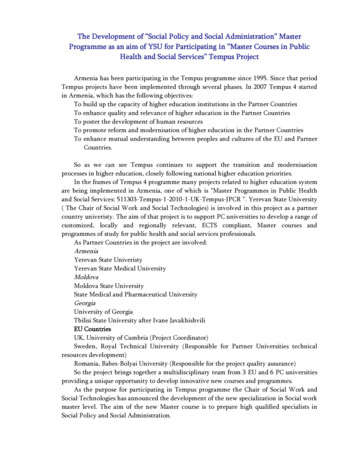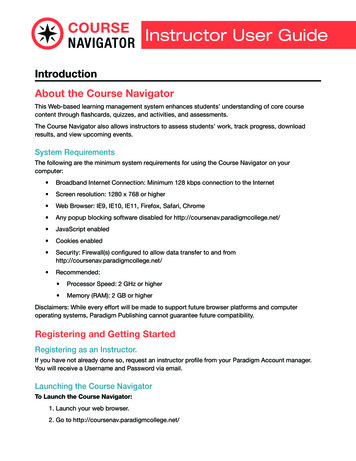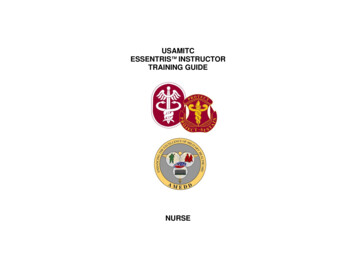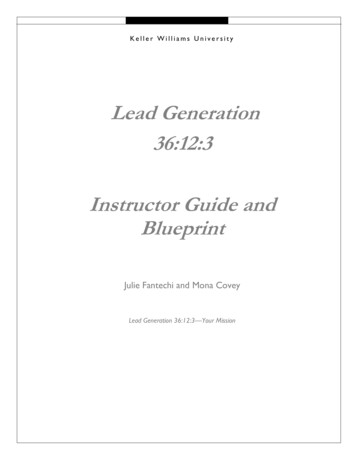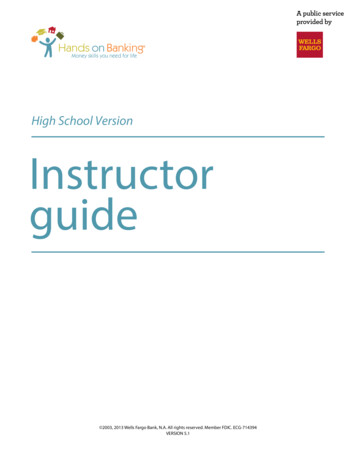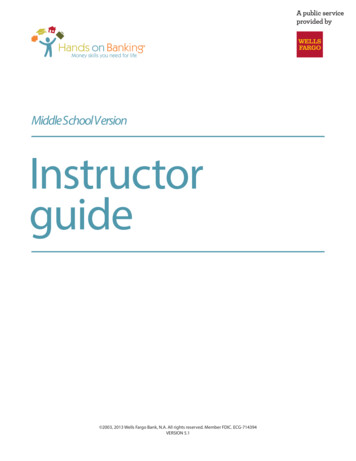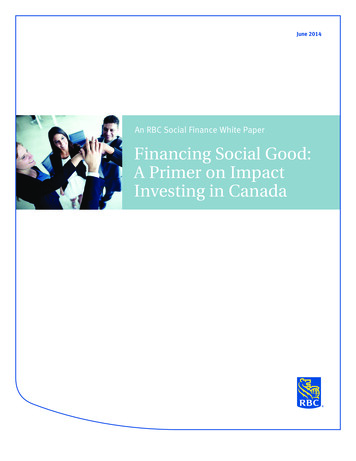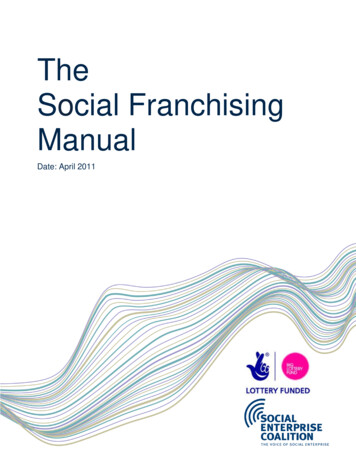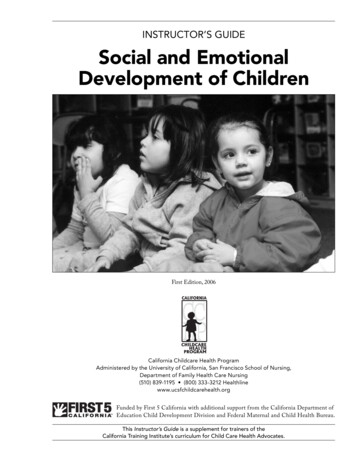
Transcription
INSTRUCTOR’S GUIDESocial and EmotionalDevelopment of ChildrenFirst Edition, 2006California Childcare Health ProgramAdministered by the University of California, San Francisco School of Nursing,Department of Family Health Care Nursing(510) 839-1195 (800) 333-3212 Healthlinewww.ucsfchildcarehealth.orgFunded by First 5 California with additional support from the California Department ofEducation Child Development Division and Federal Maternal and Child Health Bureau.This Instructor’s Guide is a supplement for trainers of theCalifornia Training Institute’s curriculum for Child Care Health Advocates.
INTRODUCTION TO THESOCIAL AND EMOTIONAL DEVELOPMENTOF CHILDREN MODULEThis Instructor’s Guide provides trainers with an outline for the teaching of the Social and EmotionalDevelopment of Children module. Participants will learn what social and emotional development means forinfants and young children. Trainers will instruct Child Care Health Advocates (CCHAs) in how they canpromote the social and emotional development of infants and young children by forming warm relationships with children and families, providing developmental screenings, and learning how to observe andunderstand challenging behaviors.Learning Objectives:1. To describe the social and emotional development of young children.2. To identify why young children behave in different ways.3. To describe the impact children with challenging behaviors have on early care and education (ECE)programs, staff and families.4. To describe three ways a CCHA can assist ECE programs with meeting the needs of children withbehavioral health problems.5. To identify resources available to assist and support ECE providers and families.Primary Messages:1. Children exhibit a wide range of normal feelings and behaviors, which are affected by child, familyand environmental factors.2. The most important role a CCHA can play in the promotion of social and emotional development inchildren is to model and encourage caring relationships between providers, families and children.3. Behavioral problems can cause frustration for staff and parents.4. All behavior in children has meaning, even if we do not yet understand what the meaning is.5. Challenging behavior can be improved by observing the child and speaking with the family in orderto understand the meaning of the child’s behavior.6. There are risk factors and protective factors in a child, family or community that interact to affect achild’s social and emotional development.7. CCHAs can promote developmental screening in order to identify areas that may need furtherassessment.8. CCHAs can maintain and update a resource file on community resources for typical problematicbehaviors and on other resources that promote social and emotional development.Instructor’s Guide: A Curriculum for Child Care Health AdvocatesnSocial and Emotional Development of Childrenn1
Materials and Equipment Needed:1. Copy of module: Social and Emotional Development of Children2. Copy of Instructor’s Guide: Social and Emotional Development of Children3. Flip chart/whiteboard and markers, or chalkboard and chalk4. Masking tape for posting flip chart paper5. LCD projector or overhead projector6. Computer for PowerPoint slides7. CDs of slides or transparencies8. Handoutsa. Handouts in the Social and Emotional Development of Children modulei. Handouts from California Childcare Health Program (CCHP), Oakland, CAPage Numberin ModuleHandout TitleHealth and Safety Notes: Biting in the Child Care Setting31Health and Safety Notes: Caring for the Spirited Child33Health and Safety Notes: Temperament and Regularity35Health and Safety Notes: Understanding and Caring for the Child with AD/HD37ii. Handouts from Program for Infant/Toddler Caregivers (PITC), Sausalito, CAPage Numberin ModuleHandout TitleGoals for the Emotionally Healthy Child at Age Three or Four39Temperament Assessment Scale for Caregivers43Temperament Assessment Scale for Children45Understanding a Child’s Behavior. PITC Activity: Think of a Child.47Things to Consider. PITC Activity: Think of a Child.48Temperament and Behavior. PITC Activity: Think of a Child.49Attitudes and Actions. PITC Activity: Think of a Child.50iii. Handouts from other sourcesPage Numberin ModuleHandout TitleBehavioral Data Collection Sheet51Special Care Plan for a Child with Behavior Problems53Temperament and Goodness of Fit55b. Handouts in the Instructor’s GuideAppendix TitleAppendix NumberUsing the Social and Emotional Development of Children Module2nSocial and Emotional Development of Childrenn14AInstructor’s Guide: A Curriculum for Child Care Health Advocates
SUGGESTED TRAINING OUTLINEOutlineI. Introduction to the Social and Emotional Development of Children ModuleA. Assessment of Group KnowledgeMethodTime(Minutes)—10Questioning2B. Introduction/Rationale to the Social and EmotionalLectureDevelopment of ChildrenC. The Role of the CCHA in Promoting the SocialLecture and Discussionand Emotional Development of ChildrenII. Social and Emotional Development of Young Children —A. Social and Emotional Milestones3545–60Lecture and Discussion10B. Optional: Child Development from Birth to 5 Years Old Small Group Activity10C. Goals for the Emotionally Healthy Child at AgeThree or FourHandout Review5D. Temperament and BehaviorLarge Group Activity10E. Understanding Children’s BehaviorSmall Group Activity10F. Managing Challenging BehaviorLecture and Small Group Activity10G. Optional: Developmental Screening InstrumentsSmall Group Discussion5—20A. Working with ParentsLarge Group Activity10B. Special Care PlanHandout Review10—10–20III. Parents as PartnersIV. Summary and ClosureA. Optional: Using the Social and Emotional DevelopmentSmall Group Activityof Children Module10B. Next Steps for the CCHALarge Group Discussion5C. Summary and ClosureBrief Closing Activity5Total time: 85–110 minutesInstructor’s Guide: A Curriculum for Child Care Health AdvocatesnSocial and Emotional Development of Childrenn3
OUTLINE AND INSTRUCTIONSSocial and Emotional Development of ChildrenI. Introduction to the Social and Emotional Development of Children ModuleA. Topic: Assessment of Group KnowledgeMethod: QuestioningInstructions:1. Ask participants several of the following questions, choosing questions most appropriate foryour participants. Ask them to raise their hand if they: Know what a medical home is. Provide health screenings. Help parents gain access to health insurance for their children. Monitor which children have preventive care.B. Topic: Introduction/Rationale to the Social and Emotional Development of ChildrenMethod: LectureInstructions:1. State that research shows that the care received in infancy and early childhood are crucial tobrain development and social and emotional development. Therefore, ECE providers haveboth an opportunity and a professional obligation to promote social and emotional wellnessby working with ECE providers, children and families in ways that support healthy childdevelopment.2. State that because ECE providers have so much contact with both children and families,they are in a critical position to observe children and to support families in caring for theirown unique child. The role of the CCHA is to help ECE providers and families worktogether to support children’s social and emotional development, as well as to provide resources and referrals for families who need them.C. Topic: The Role of the CCHA in Promoting the Social and Emotional Developmentof ChildrenMethod: Lecture and DiscussionInstructions:1. Begin by asking participants how many hours a day they spend with the children in theircare. Ask them how many hours a day the children spend in the care of their families.Clearly, the care given by ECE providers shapes these children in very significant ways.2. State that ECE providers spend a great deal of time and energy managing children’sbehavior. Since all behavior has meaning, it is important that CCHAs develop theirskills in understanding behavior and thinking about what the child exhibiting difficultbehaviors might be trying to communicate. Because CCHAs are often in the ECEprogram everyday, they can observe children playing with different people and at varioustimes across a period of several weeks. This gives them a unique opportunity to observechildren, to build individualized relationships with them and to identify early problems thatneed professional attention.4nSocial and Emotional Development of ChildrennInstructor’s Guide: A Curriculum for Child Care Health Advocates
3. State that in order to promote healthy social and emotional development, CCHAs rely ontheir understanding of child development and their ability to develop warm relationshipswith children, ECE providers and families. It is the role of the CCHA to:a. Develop warm relationships with children, providers and families.b. Model positive behavior.c. Educate ECE providers and families about positive guidance and temperament.d. Observe and document children’s behavior.e. Provide resources and links with health professionals.f. Understand cultural differences regarding what is acceptable and unacceptable behaviorin different cultures.II. Social and Emotional Development of Young ChildrenA. Topic: Social and Emotional MilestonesMethod: Lecture and DiscussionInstructions:1. Begin by emphasizing how important ECE providers are in the healthy development ofchildren. Their consistent, warm and attentive care shapes children in ways that will affectthem for the rest of their lives. In order to provide this care, it is important to understandchild development.2. State that children’s early social and emotional development depends on a variety offactors, including genetics, environment and the community. State that these influencesaffect development in a number of ways. Write two column headings on a flip chart:Influence and Effect. Then ask participants to think about the influences on the child’sdevelopment within the first 5 years and the effect that these influences could have. Givethe example of caring relationships as an influence, with the effect(s) as the ability to trustothers and/or feeling of confidence. After they have had a moment to reflect, ask participantsto share their answers as the trainer writes them on the flip chart. Add key influences andeffects if they are missing (refer to page 2 of the module).3. Introduce the concept of risk factors and protective factors. Risk factors are obstacles tohealthy development. Use any examples generated by participants above. Protectivefactors are those that help children become resilient so they can bounce back fromproblems that arise.4. State that ECE providers can serve as very important community support systems tofamilies of young children. Quality ECE programs can help protect children at riskby providing:a. a caring relationship with a primary ECE providerb. inclusion in the groupc. high expectations for each childd. recognition of the child’s ability and hope for the child’s futureInstructor’s Guide: A Curriculum for Child Care Health AdvocatesnSocial and Emotional Development of Childrenn5
5. Summarize by saying that these are protective factors. Even though we cannot prevent badthings from happening to families and children, we can promote healthy development byproviding these protective factors.B. Optional Topic: Child Development from Birth to 5 Years OldMethod: Small Group ActivityInstructions:1. Divide participants into seven groups and ask them to list typical behaviors for children in theseage groups. Ask them to state the earliest age these behaviors might develop and the latest ages(even if the latest ages fall into the next stage).a. 0 to 6 monthsb. 6 months to 1 year oldc. 1 year old to 18 monthsd. 18 months to 2 years olde. 2 to 3 years oldf. 3 to 4 years oldg. 4 to 5 years old2. Debrief and summarize by acknowledging the normal range and variation of typical behaviors.C. Topic: Goals for the Emotionally Healthy Child at Age Three or FourMethod: Handout ReviewInstructions:1. Ask participants to think about and write down a few milestones an ECE provider wouldobserve in an emotionally healthy child at ages 3 to 4.2. Direct participants to Handout: Goals for the Emotionally Healthy Child at Age Three or Four(page 39 in module) and ask them to fill in the blanks in the handout. Discuss the goalslisted in this handout and how ECE providers may help children develop them.D. Topic: Temperament and BehaviorMethod: Large Group ActivityInstructions:1. Ask participants to define temperament: Temperament is the natural, inherited style ofbehavior of each person. It is a combination of inborn traits and personal experience thatshapes how we see and respond to the world around us. It is the “how” of behavior, not the“why.”2. Explain that although many factors contributing to behavior may change, temperament isinborn and will not change. Review the nine types of temperamental characteristics on page6 of the module.3. Direct participants to Activity 2: Temperament Treasure Hunt on page 17 of the module. Askparticipants to follow the directions at the top of the handout.4. Ask participants to make general comments regarding their observations. Note that thesebehaviors are shaped by temperament.6nSocial and Emotional Development of ChildrennInstructor’s Guide: A Curriculum for Child Care Health Advocates
5. State that Activity 2: Temperament Treasure Hunt (page 17 in module), Handout:Temperament Assessment Scale for Caregivers (page 43 in module) and Handout: Temperamentand Goodness of Fit (page 55 in module) provide an opportunity for caregivers to learnmore about themselves and about how their temperament traits may affect the relationshipsthey have with children in care.6. Instruct participants to complete Handout: Temperament Assessment Scale for Caregiverson page 43 of the module. Discuss the importance of being aware of how temperamentand culture affect our relationships, not only with children in care but with other staff andparents. Encourage participants to continue reflecting on their own temperament and itsimpact on their work after the training.E. Topic: Understanding Children’s BehaviorMethod: Small Group ActivityInstructions:1. State that behavior is the main way children let adults know what their needs are. Youngchildren who cannot yet speak often communicate by using body language and emotionalexpressions. Children from birth to 5 years of age have a limited ability to understandand express themselves, but their general behavior can tell us a great deal. There are severalfactors to consider when determining the meaning of their behavior.2. Optional: Ask participants to generate a list of behaviors that indicate to ECE providers thatchildren are stressed or overwhelmed. Refer to page 3 of the module.3. State that it is important to understand a child’s behavior. The Program for Infant-ToddlerCaregivers (PITC) defines five possible causes of behavior in young children. Refer to Table1 on pages 4 to 5 of the module:a. developmental stageb. individual differencesc. the environmentd. the child does not know but is ready to learne. unmet emotional need4. Divide participants into small groups. It is ideal to have participants from the same ECEprogram grouped together. Ask each group to think of one child in their program who hasa challenging behavior. Direct participants to Activity 3: Understanding a Child’s Behavior(page 18 in module) and have them follow the instructions. (Note to Trainer: This activityasks participants to refer to Table 1 on pages 4 to 5 of the module.)5. Emphasize the importance of observation in the management of challenging behaviors.F. Topic: Managing Challenging BehaviorMethod: Lecture and Small Group ActivityInstructions:1. Ask participants to list some challenging behaviors in their setting.2. Ask them what strategies have been successful in helping them to manage these behaviors.Instructor’s Guide: A Curriculum for Child Care Health AdvocatesnSocial and Emotional Development of Childrenn7
3. State that the following challenging behaviors need continued attention and possiblereferral if they:a. Get in the way of the child’s successful learning or play.b. Are harmful to the child or others.c. Result in isolating the child.d. May result in later social or school problems.4. State that these challenging behaviors will need to be addressed by the ECE staff. Statethat although these types of behaviors are common, they still merit serious attention.5. Break into small groups. Ask participants to read the cases on pages 7 to 8 of the module.Discuss each one after reading. Ask participants to discuss what actions were taken by theCCHA and what communications happened between parents and ECE providers.6. State that in order to address challenging behaviors that continue despite ECE providers’attempts to manage them, providers should:a. Observe and document the child’s behavior over time to identify patterns of behavior.b. Get information from the family about the child’s history, relationships and behaviorat home.c. Have another person observe the child.d. Summarize the concerns about the child’s behavior with the parents and togetherdevelop strategies to meet the child’s needs (see Handout: Special Care Plan for a Childwith Behavior Problems on page 53 of the module).e. Ask that a mental health consultant observe and assess the child and provide, with theparent’s consent, strategies for intervention.G. Optional Topic: Developmental Screening InstrumentsMethod: Small Group DiscussionInstructions:1. State that identifying areas that need early intervention is difficult for ECE providers becausethere is such a wide range of healthy, normal development in children. To ensure that areas ofconcern will not be overlooked, ECE providers should encourage their ECE programs to conductroutine, developmental screenings.2. Group participants according to their workplace, with those from the same program groupedtogether. Refer participants to the list of developmental screening tools on pages 11 to 12 of themodule. Ask them to discuss how they might incorporate more developmental screening intotheir programs.III. Parents as PartnersA. Topic: Working with ParentsMethod: Large Group ActivityInstructions:1. Ask participants to describe how establishing partnerships with parents and familiesbenefits the children in their program.2. Ask participants to describe the ways they go about encouraging partnerships betweenproviders and staff (refer to page 10 in module).8nSocial and Emotional Development of ChildrennInstructor’s Guide: A Curriculum for Child Care Health Advocates
B. Topic: Special Care PlanMethod: Handout ReviewInstructions:1. Direct participants to think of a child in their program. Ask them to go through Handout:Special Care Plan for a Child with Behavior Problems on page 53 of the module with thischild in mind.2. Debrief: Ask participants to describe the value of using this form for staff, childrenand families.If you have experienced CCHAs in the room, do one or more of the following:1. Group them in separate groups and ask them to share with each other the developmentalscreening tools they use.2. Ask them how they work to develop warm and caring relationships with children.3. Ask them to describe how they talk to parents about observations or concerns about children intheir care.4. Pair them up with nonexperienced participants and instruct the nonexperienced to ask questionsof the experienced CCHAs about promoting social and emotional development.IV. Summary and ClosureA. Optional Topic: Using the Social and Emotional Development of Children ModuleMethod: Small Group ActivityInstructions:1. Explain to the participants that the curriculum is a rich resource for them and encourage themto become familiar with it. Towards this end, spend a few minutes looking through it together.Explain that participants will work in pairs to go through the module to find the answers tothese questions.2. Han
Administered by the University of California, San Francisco School of Nursing, Department of Family Health Care Nursing (510) 839-1195 † (800) 333-3212 Healthline www.ucsfchildcarehealth.org Funded by First 5 California
